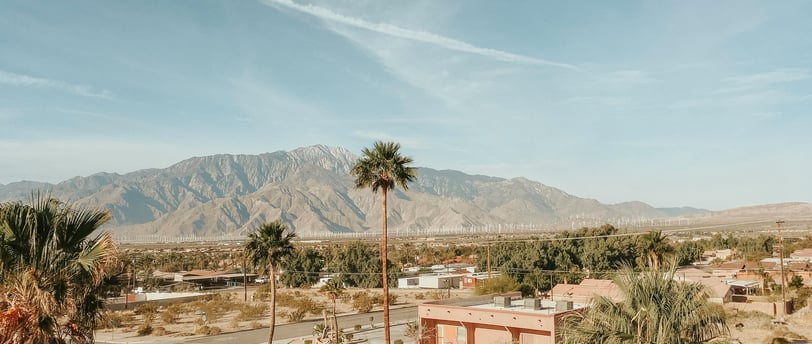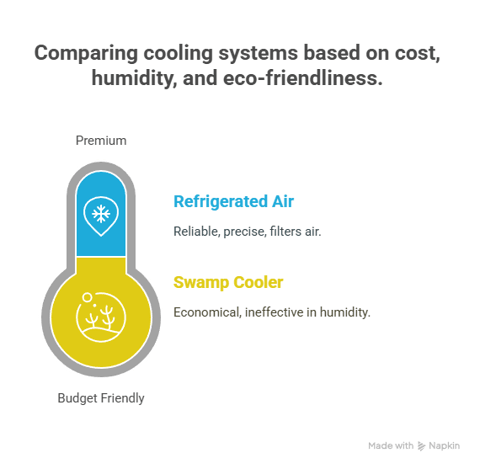Refrigerated Air vs. Swamp Coolers: The Ultimate Showdown for El Paso's Climate
What are the pros and cons of refrigerated air and swamp coolers?
5/22/20255 min read


Introduction to Cooling Systems in El Paso
El Paso, situated in the arid desert of West Texas, experiences extreme temperatures during the summer months, often exceeding 100 degrees Fahrenheit. The necessity for efficient cooling systems is vital for maintaining comfort in residential and commercial spaces alike. Among the prevalent cooling options available to El Paso residents, two primary systems frequently come into consideration: swamp coolers and refrigerated air conditioning units.
Historically, swamp coolers, also known as evaporative coolers, have been a popular choice for cooling in drier climates like El Paso. These systems work on the principle of evaporative cooling, which involves drawing hot air through wet filters. The evaporation of water leads to a drop in temperature, making it a cost-effective option, especially for those seeking to minimize energy consumption. Due to El Paso’s low humidity levels, swamp coolers can effectively lower indoor temperatures, making them suitable for many households for decades.
However, the landscape of cooling technology has evolved significantly over the years, leading to a growing preference for refrigerated air conditioning units. Refrigerated air systems utilize a closed-loop system that compresses refrigerant gas to absorb heat and release cool air. The energy efficiency, consistent cooling performance, and ability to dehumidify the air make refrigerated air systems increasingly appealing to residents who seek modern conveniences and temperature control throughout the entire year. With minimal maintenance and a variety of energy-efficient models, these systems have positions themselves as a compelling alternative to traditional swamp coolers.
As the climate continues to demand effective solutions for heat management, understanding the strengths and weaknesses of both cooling systems will enable homeowners and businesses in El Paso to make informed decisions suited to their needs. The following sections will embark on a detailed comparison of refrigerated air and swamp coolers to ascertain which system stands as the better choice for El Paso's unique climate.
Performance Analysis: Refrigerated Air vs. Swamp Coolers
In the context of El Paso's intense climate, the performance of cooling systems can greatly affect comfort and energy consumption. Refrigerated air systems, commonly known as air conditioners, utilize a closed-loop system to remove heat and humidity from indoor air, ensuring consistent temperature regulation and effective humidity control. This system operates by cycling refrigerant through a series of coils, allowing for efficient cooling, typically achieving temperatures significantly lower than outdoor conditions, even during the scorching summer months.
On the other hand, swamp coolers, or evaporative coolers, harness the process of evaporation to lower temperatures. These systems draw in hot, dry air and pass it over water-saturated pads. As the air evaporates the water, it results in a cooling effect. While swamp coolers can effectively reduce temperatures in drier environments, their performance is heavily influenced by humidity levels. In El Paso, where humidity is often low, these coolers can perform well; however, effectiveness diminishes significantly in higher humidity conditions.
Energy efficiency is another critical component of the performance analysis. Refrigerated air systems tend to consume more energy due to the electricity required to run compressors and fans. However, their ability to maintain stable indoor temperatures often results in fewer fluctuations, leading to potential energy savings in some cases. Swamp coolers, in contrast, generally consume significantly less energy, making them a more budget-friendly option for cooling. Yet, their reliance on outdoor humidity can lead to inconsistent indoor temperatures on particularly humid days.
When comparing cooling capacity, refrigerated air systems typically provide superior performance, effectively cooling larger spaces while maintaining a comfortable environment. User experiences reveal varying satisfaction levels; those in favor of refrigerated air systems often cite reliability and consistent comfort, while swamp cooler users appreciated the lower operational costs and simplicity of installation. Overall, the ideal choice of cooling system for an individual in El Paso depends on personal preferences and specific environmental conditions.
Cost Considerations: Dollars and Convenience
When comparing refrigerated air systems to swamp coolers, it is crucial to analyze the financial implications encompassing installation costs, maintenance expenses, and energy consumption. Refrigerated air conditioning systems typically require a larger initial investment. Installation can be complex and may involve ductwork, which can considerably increase overall expenses. On the other hand, swamp coolers, also known as evaporative coolers, tend to have lower upfront costs. Their installation is generally simpler, as they rely on direct evaporation and can often be placed in existing structures without extensive modifications.
Maintenance is another pivotal factor affecting cost. Refrigerated air systems usually require regular servicing, including filter replacements and checks for mechanical issues, which can accumulate over time. However, the convenience of automated controls and reliable temperature regulation may justify these recurrent costs for some homeowners. Conversely, swamp coolers demand periodic maintenance as well; however, this is often less intensive and can be performed easily by the homeowner. Cleaning the cooling pads and ensuring adequate water supply are basic tasks that can be completed without professional assistance.
Energy consumption is essential to consider for long-term savings. Refrigerated air conditioning units consume significant electricity, especially in places like El Paso, where the climate demands extensive cooling during peak summer months. Swamp coolers operate using less electricity, relying primarily on water evaporation for cooling, which can lead to substantial savings on utility bills. Nevertheless, efficiency can diminish if the outdoor humidity rises, impacting cooling effectiveness. Evaluating how frequently each system will be used and the associated operational costs will provide insight into their total cost of ownership. The choice between refrigerated air and swamp coolers ultimately hinges on balancing upfront investments with ongoing expenses and overall convenience related to maintenance and usage.
Conclusion: Which System Reigns Supreme in El Paso?
In the quest for effective cooling solutions in El Paso's arid climate, both refrigerated air systems and swamp coolers offer distinct advantages and drawbacks. Refrigerated air conditioning stands out for its ability to deliver consistent and precise temperature control, making it particularly well-suited for homeowners seeking a reliable and comfortable indoor environment. This system is especially beneficial during peak summer when temperatures can soar, providing relief from the oppressive heat.
On the other hand, swamp coolers present a more eco-friendly and economical alternative. Utilizing the principle of evaporative cooling, these devices are often less expensive to install and operate, appealing to budget-conscious homeowners. They work effectively in dry climates, making them a practical choice for areas with low humidity like El Paso. However, it is important to note that swamp coolers can be less effective during periods of high humidity, which may limit their efficacy at certain times of the year.
When choosing between these two cooling systems, homeowners should consider individual preferences, energy efficiency, and specific cooling needs. For those prioritizing comfort and temperature regulation, refrigerated air conditioning may be preferable. In contrast, individuals looking for cost-effective and environmentally friendly options may lean towards swamp coolers. Ultimately, the decision should reflect personal priorities—balancing initial costs against long-term energy bills and maintenance. By weighing the pros and cons of each system, El Paso residents can make informed decisions, ensuring their homes remain cool and comfortable throughout the intense summer months.


